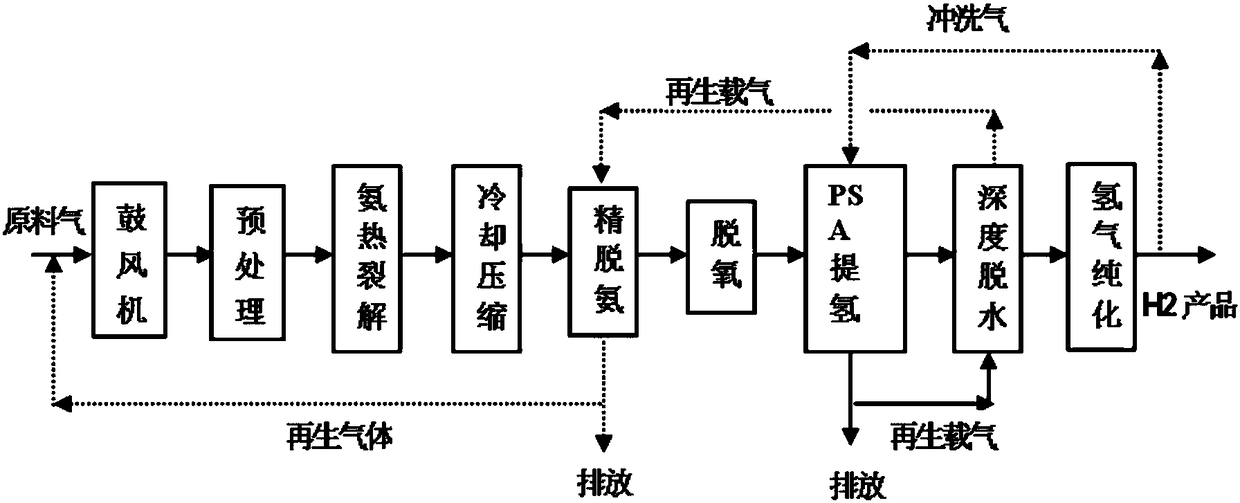Method for FTrPSA (full temperature range-pressure swing adsorption) hydrogen production recycling of high-concentration ammonia-containing tail gas from LED-MOCVD (light emitting diode-metal oxide chemical vapor deposition) processing
A pressure swing adsorption, high concentration technology, applied in separation methods, chemical instruments and methods, hydrogen separation, etc., can solve problems such as difficult recycling, achieve the effect of reducing exhaust emissions, good activity and diffusivity, and solving technical bottlenecks
- Summary
- Abstract
- Description
- Claims
- Application Information
AI Technical Summary
Problems solved by technology
Method used
Image
Examples
Embodiment 1
[0037] Such as figure 1 As shown, a LED-MOCVD process high-concentration ammonia-containing waste gas full-temperature pressure swing adsorption hydrogen production reuse method, the raw material gas treated by normal pressure or low pressure MOCVD (metal oxide chemical vapor deposition) is prepared based on gallium nitride ( The exhaust gas in the light-emitting diode (LED) process of GaN) epitaxial wafer growth, its main composition is nitrogen (N2): 46% (v / v, the following is similar), hydrogen (H2): 34%, ammonia (NH3): 19%, the remaining 1% is a small amount of metal ions, particles, arsenic, methane (CH4), water (H2O), carbon monoxide (CO), carbon dioxide (CO2), oxygen (O2) and other impurity components, the pressure is normal Pressure, the temperature is 50 ~ 70 ℃, the specific implementation steps include,
[0038] (1) Pretreatment, the raw material gas is sent to the pretreatment unit consisting of a dust collector, a particle filter, and an oil mist collector through...
Embodiment 2
[0046] Such as figure 1 As shown, on the basis of Example 1, the raw material gas temperature is 20-30°C, and the rest remain unchanged. The high-temperature product gas generated in the hydrogen purification process is heat-exchanged with the raw material gas to restore its temperature to 50-70°C, and Carry out operation by embodiment 1. The purpose is to prevent the high concentration of ammonia in the raw gas from easily escaping into liquid at a temperature of 20°C lower than the ambient temperature and damaging the equipment in the pretreatment process.
Embodiment 3
[0048] Such as figure 1 As shown, on the basis of Example 1, the more optimal composition of the ammonia thermal cracking catalyst is cobalt (Co)-molybdenum (Mo) bimetal active component, silicon (Si)-carbon nanotube (CNTs) carrier, potassium salt As a modifier, the decomposition rate of ammonia is greater than or equal to 95-99%, the reaction bed can be in the form of a whole tube, and the reaction temperature is reduced to 400-450°C.
PUM
 Login to View More
Login to View More Abstract
Description
Claims
Application Information
 Login to View More
Login to View More - R&D
- Intellectual Property
- Life Sciences
- Materials
- Tech Scout
- Unparalleled Data Quality
- Higher Quality Content
- 60% Fewer Hallucinations
Browse by: Latest US Patents, China's latest patents, Technical Efficacy Thesaurus, Application Domain, Technology Topic, Popular Technical Reports.
© 2025 PatSnap. All rights reserved.Legal|Privacy policy|Modern Slavery Act Transparency Statement|Sitemap|About US| Contact US: help@patsnap.com

